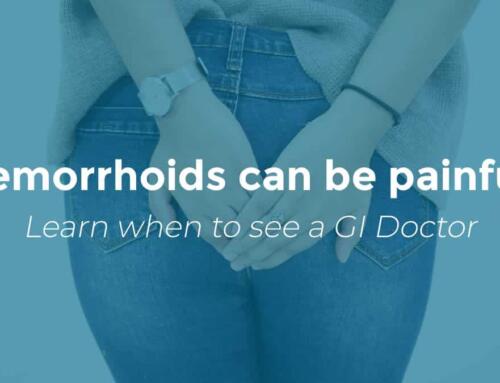Hemorrhoids can be embarrassing to talk about. But they are a widespread problem that people deal with every day. In fact, up to 35% of the U.S. adult population will experience hemorrhoids during their lifetime.
Contrary to popular belief, hemorrhoids are not just an older person’s disease. They can affect people of all ages.
The good news is that hemorrhoids are easy to fix when treated early.
I recently talked about hemorrhoids on my Gut Check Podcast with Eric Rieger, CRNA. This article will highlight our conversation, including what hemorrhoids are, what causes them, and how you can get rid of them once and for all. If you want to hear more, you can listen to the podcast episode here.
What Are Hemorrhoids?
Hemorrhoids are a natural collection of veins inside the anal canal that work like shock absorbers to help you maintain continence. Everyone has hemorrhoids. But you only notice them when they become enlarged.
If too much pressure builds up within your rectal area, hemorrhoids can swell and cause uncomfortable symptoms.
Symptoms of hemorrhoids may include:
- Bright red rectal bleeding
- Uncontrolled leakage of stool
- Itching around the anus
- Pain
Some types of hemorrhoids aren’t visible because they’re located within the anal canal. Other types of hemorrhoids may look like lumps protruding from the anus.
Types of Hemorrhoids
There are two types of hemorrhoids: internal and external hemorrhoids.
Internal hemorrhoids lie above the dentate line, also known as the pectinate line. This is an anatomical junction that divides the anal canal into upper and lower portions. Interestingly, the upper part of the anal canal isn’t innervated by pain receptors. Above the dentate line, the anal canal is only sensitive to stretching. This means that internal hemorrhoids are usually painless.
The following grades classify internal hemorrhoids:
- Grade 1: hemorrhoids prolapse past the dentate line during straining
- Grade 2: hemorrhoids prolapse outside the anus during straining but spontaneously reduce
- Grade 3: hemorrhoids prolapse outside the anus during straining and can only reduce manually
- Grade 4: hemorrhoids prolapse outside the anus and cannot reduce
External hemorrhoids lie below the dentate line. This portion of the anal canal is sensitive to pain, touch, and temperature. External hemorrhoids often cause pain, especially when a blood clot forms within the swollen vein. Thrombosed external hemorrhoids may appear bluish in color due to lack of blood flow.
Causes of Hemorrhoids
There are many potential causes of hemorrhoids. Anything that increases pressure within the rectal area can cause hemorrhoids to swell and bulge.
Straining the pelvic floor muscles is a common cause of hemorrhoids. This can occur during bowel movements, heavy lifting, and normal daily activities. Many people unknowingly contract their pelvic floor muscles due to improper breathing techniques and poor posture.
Surprisingly, western toilets don’t promote proper posture for emptying your bowels. This is because the anorectal angle only straightens during squatting, which allows for the passage of stool. Improper toilet posture can cause you to spend more time on the toilet and unnecessarily strain your pelvic floor muscles.
Many health conditions can also contribute to hemorrhoids, such as:
- Pregnancy
- Obesity
- Colon cancer
- Constipation
- Chronic diarrhea
- Pelvic floor dysfunction
- Liver disease
Interestingly, genetics may also play a role in your risk of developing hemorrhoids. Certain people have reduced elasticity in their veins, making it more likely for hemorrhoids to become engorged and distended.
Hemorrhoid Treatments
Hemorrhoid treatments vary depending on the location and severity of hemorrhoids.
Conservative Treatments
Often, conservative treatments can relieve your symptoms.
Conservative hemorrhoid treatments may include:
- Eating 25-35 grams of fiber per day
- Taking a fiber supplement
- Drinking more water
- Using a stool softener
- Taking sitz baths
- Being more active during the day
- Taking a horse chestnut supplement like Atrantil
However, if hemorrhoids don’t resolve on their own, some treatments can remove them permanently.
Hemorrhoid Banding
Hemorrhoid banding, also known as rubber band ligation, is a non-invasive, outpatient procedure that can treat grades 1-3 internal hemorrhoids.
My office uses a modified banding procedure that is quick and painless, known as the CRH O’Regan System. During the procedure, I place a rubber band at the base of hemorrhoid. This causes the hemorrhoid to fall off, leaving scar tissue in its place. The scar tissue reduces blood flow to the area, which prevents hemorrhoids from bulging.
You don’t need to prepare for this procedure beforehand or cancel your daily plans. Incredibly, treatment with the CRH O’Regan System takes only minutes and requires no downtime.
Hemorrhoid banding is one of the most effective treatments for internal hemorrhoids. This treatment has a high success rate and is extremely safe with a low risk of side effects.
Surgery
Surgical treatments for hemorrhoids are more invasive, which also means they pose more significant health risks. Unfortunately, surgery may be the only option to treat severe cases of internal and external hemorrhoids.
Surgery for hemorrhoids may include:
• Closed hemorrhoidectomy
• Open hemorrhoidectomy
• Stapled hemorrhoidopexy
• Hemorrhoidal artery ligation
Surgical hemorrhoid treatments generally have good outcomes. But the recovery process is longer and more painful than other treatments.
How to Prevent Hemorrhoids
You can prevent hemorrhoids by making diet and lifestyle changes that reduce pressure on the pelvic floor.
If you want to lower your risk of hemorrhoids, follow these tips:
- Eat a high-fiber diet to make your stools easier to pass
- Drink plenty of water to soften stools
- Avoid pushing or straining during bowel movements
- Use a position of having your knees above your hips when using the toilet. This can be accomplished by using books to elevate your knees or with a product like the Squatty Potty
- Practice proper breathing techniques when lifting to avoid bearing down on your pelvic floor muscles
- Spend no more than 3-5 minutes on the toilet
- Don’t bring your phone to the bathroom to avoid sitting on the toilet for too long.
- Maintain a healthy weight
- Exercise regularly to improve bowel motility
When to See a Doctor for Hemorrhoids
Hemorrhoids are a common annoyance for many people. But, sometimes, they can turn into a medical complication if not treated.
You should see a doctor for hemorrhoids as soon as you notice symptoms. Some symptoms associated with hemorrhoids, such as rectal bleeding, may have other causes. Alternative causes may include colon cancer, inflammatory bowel disease (IBD), and proctitis.
Rectal bleeding is never normal and should always receive an evaluation by a medical professional.
The earlier you seek treatment for hemorrhoids, the easier treatment is. If you wait weeks or months to get treatment, your hemorrhoids may progress to later grades.
If you want to get rid of hemorrhoids for good, you can call my office at 972-867-0019 or schedule an appointment online.



